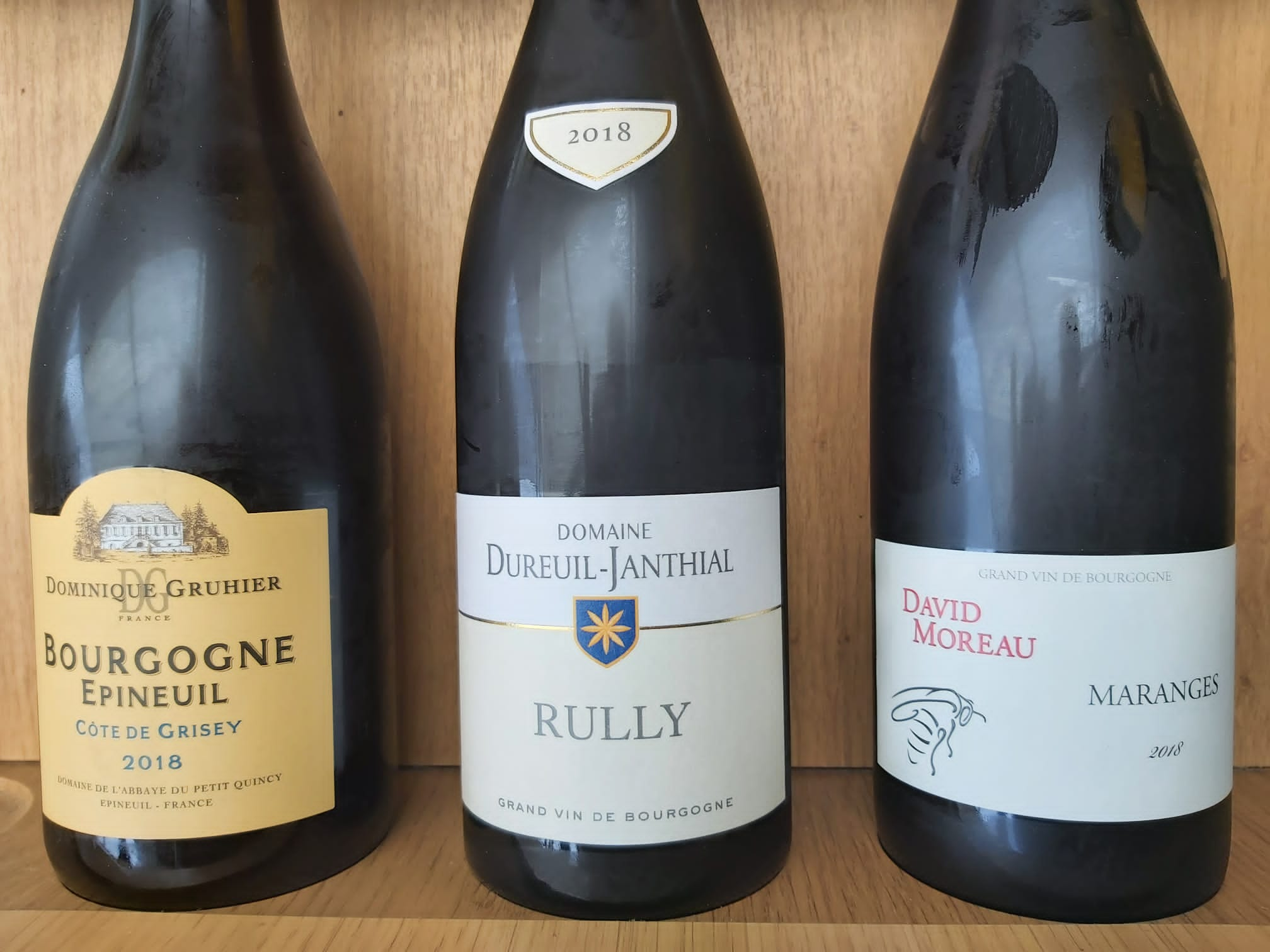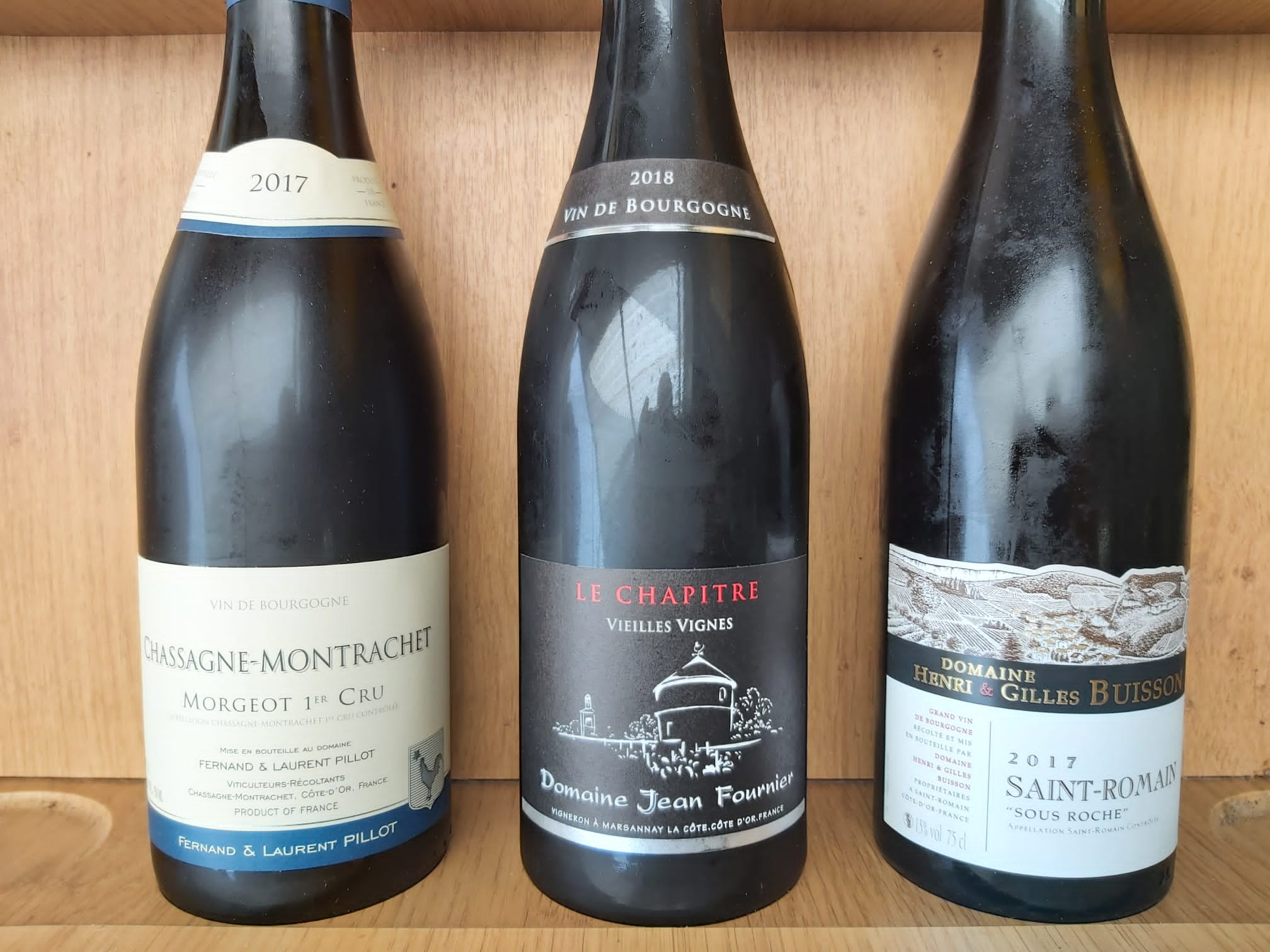I was awaiting this tasting with eager anticipation because of the more unusual nature of the wines that we would be tasting. Young Burgundy is certainly a genre that I have little experience of, preferring more mature wine from this region, so I was intrigued as to how these relative youngsters would stand up against their more mature brethren, especially being led through by someone as pre-eminent as Jasper.
I must also add that this is my first write-up for the OWC, being a relative newcomer to the Club, so please read forgivingly..
Jasper opened with the stark reality that currently mature Burgundy is somewhat of a rarity in-country, stating that even when eating out, 2019 is about the best you can find at the moment on wine lists. All the wines that we tasted this evening are from either 2017 or 2018 current Vintages and are from 6 appellations. Both of these Vintages are considered ‘hot years’ and Jasper’s brief summary of the significant challenges facing producers in this region in the light of climate change have been brought sharply in to focus in the last 3 years - vines have been dying off on some of the more drought-prone Terroirs, healthy trees have died and even beehives have died due to the heat. The age-old debate of irrigation has been brought to the fore once again of course. Classic Burgundian rootstocks just aren't working any more in the context of the more extreme and prolonged droughts and hot weather. The more mature vines have deeper root systems and seem to have survived the recent droughty years of 2018 and 2019-20 however the very rapid/accelerating change in weather patterns and climate taking place here is understandably worrying growers.
 The first wine tasted was the Bourgogne Epineuil Côte de Grisey Dominique Gruhier (2018), 13% ABV, £17.70 per bottle. The wine displayed well on the nose with a lightly vegetal overtone (stems) and white pepper. The wine showed very good colour due to the sunshine of 2018. The palate was driven by vigorous young red fruit with a long finish but was unmistakably young. Most people noted that it opened up well in the glass and became richer with time. Jasper noted it as a potentially good buy to lay down as he thought it should mature well.
The first wine tasted was the Bourgogne Epineuil Côte de Grisey Dominique Gruhier (2018), 13% ABV, £17.70 per bottle. The wine displayed well on the nose with a lightly vegetal overtone (stems) and white pepper. The wine showed very good colour due to the sunshine of 2018. The palate was driven by vigorous young red fruit with a long finish but was unmistakably young. Most people noted that it opened up well in the glass and became richer with time. Jasper noted it as a potentially good buy to lay down as he thought it should mature well.
This vineyard is located just north of Tonnere, NW of Chablis. Epineuil is a tiny commune/regional appellation of only 100 hectares and is regarded as a bit of a special ‘backwater’ in the region, producing some world-class wines. The terroir is typically steep S-SE facing slopes in a narrow valley with Chablis-esque Kimmeridgian Limestone soils. The area is protected by the Langres Plateau, preventing the very cold winds from reaching the vineyards. Jasper tipped this as a producer to watch; Dominique Gruhier is a curious and ambitious grower and Burgundy prices are rising. At £17.70 per bottle, Jasper’s tip may well be worth following up.
The second wine tasted was the Rully Rouge Vincent Dureuil-Janthial (2018), 13% ABV, £26.04 per bottle. The nose divided opinion in the breakout rooms and some felt that their samples could indeed be faulted. Some however were very happy and indeed it was one of my favourite wines of the evening. The wine showed a deeper colour due to the 2018 vintage again. The wine displayed well on the nose with chocolate/cocoa richness. On the palate, the wine showed black fruit with hints of cocoa, higher in acidity than the first wine but was nicely balanced with a pleasant fruit-acid balance as opposed to fruit-tannin. Some felt that the wine was not as fresh as it perhaps should have been and was slightly oxidised however I could not detect this in my sample.
Domaine Dureuil-Janthial is widely regarded as being the leading Domaine of the Côte Challonnaise. The family have been in Rully since the 18th Century It is a very traditional/classic and meticulously run vineyard, certified Organic in 2009. He is widely regarded as a perfectionist which translates through to his excellent wines. All reds are de-stemmed and held in-barrel for a year before bottling.
The third wine tasted was the Maranges, David Moreau (2018), 13% ABV, £17.50 per bottle.
The nose was lightly perfumed and slight; it had a good deep colour, tending towards purple and punched harder on the palate than some of the other wines of the evening with a tinge of liquorice and a firm, spicy edge. It displayed more body and a distinct yet subtle minerality with bigger red fruit and had a notable length on the finish.
Maranges is a fascinating village appellation at the Southern end of the Cote De Beaune. In 1988, three separate, unused ‘mini’ appellations were combined to form Maranges. It is located on a classic SE-facing escarpment that forms the Côte D’Or and just under 200 Hectares. This wine is made from old Premier Cru vines, some on red clay planted in 1947, some on decomposed granite planted in 1943.
David Moreau took over his octogenarian Grandfather’s vineyard in Santenay relatively recently, beginning with a 2009 vintage. He has since gone on to make a name for himself as an up-and-coming Burgundy producer and is gaining international recognition, particularly given the context of the skyrocketing prices of wines from the Côte D’Or. The wines are fully organic.
 The fourth wine tasted was the Fernand & Laurent Pillot Chassagne Montrachet 1er Cru Morgeot (2017), 13,5%, £35.70 per bottle. Lighter in colour, the nose was distinctly perfumed and inviting. I found typical quality Pinot sweet/dark velvety fruit on the palate, good structure with vibrant acidity and controlled tannins. Some noted in the breakout rooms that the acidity appeared slightly austere/dry. A very elegant and well-balanced wine with good concentration that will be rewarded with some age.
The fourth wine tasted was the Fernand & Laurent Pillot Chassagne Montrachet 1er Cru Morgeot (2017), 13,5%, £35.70 per bottle. Lighter in colour, the nose was distinctly perfumed and inviting. I found typical quality Pinot sweet/dark velvety fruit on the palate, good structure with vibrant acidity and controlled tannins. Some noted in the breakout rooms that the acidity appeared slightly austere/dry. A very elegant and well-balanced wine with good concentration that will be rewarded with some age.
Chassagne Montrachet is excellent red wine soil with heavy clay typifying the lower slopes.
Fernand and Laurent Pillot’s domaine now stands at 14.5 hectares across almost the whole length of the Côte de Beaune from Santenay to Beaune. They are fully organic. The domaine has been heralded in Decanter as ‘an address that should be better-known’. Jasper summarised this wine as representing good value from a good village in the Cote de Beaune at 1er Cru level. One for the bag maybe?
The fifth wine tasted was actually the 6th wine on the tasting schedule, the St. Romain Sous Roche Domaine Buisson (2017) 13% ABV, £32.00 per bottle. A lighter colour wine, the nose lead with intense redcurrant and cassis fruit with a hint of dried fruit in the background. A hint of spice and floral aromas were noted too. On the palate, the wine showed intense, well-defined freshness with a hint of minerality. Overall a very high quality and well presented wine.
The Buisson Estate in Saint Romain is one of the pioneering organic domaines in this part of Burgundy and has been biodynamically certified since 2018. The young winemaker Frédérick learnt his trade from some of Burgundy’s best. The family have been tending vines in this area since the 11th century and began buying up vineyards around Beaune in the 1920’s. They bought further vineyards in Corton, Pommard and Mersault in the 1980’s.
Saint-Romain is located about 3km west of Mersault and just north of Auxey-Duresses in it’s own south-facing cul-de-sac style valley. It’s one of the highest-elevation villages in the Côte de Beaune, usually offering wines that are a little less in stature than say Mersault or Puligny, but with the effects of climate change, this seems to be changing. With terroirs of typically creamy limestone with a higher proportion of marl than usual for this area, the site is extremely favourable to Pinot.
The sixth wine tasted was the Bourgogne Rouge La Chapitre VV, Domaine Jean Fournier (2018), 13% ABV, £25.10 per bottle. The colour appeared dense and rich ruby due to the ripeness of the grapes. Floral and peppery notes were noted on the nose, followed by a palate that displayed richness, concentration and energy, lightly textured tannins and a finish with a hint of minerality. Jasper noted that this wine should be age-worthy.
Laurent Fournier is a dynamic vigneron working hard to promote the Marsannay appellation. The estate was founded in the 17th century in the heart of Marsannay and now comprises 16.5 hectares. Laurent Fournier took over from his father in 2003 and since 2008 the estate has been Ecocert-certified organic. His wines typically have great depth and intensity with a great deal of ‘oomph’ as Jasper put it. They are organically-styled with a moderate use of sulphur which gives the wines a fine energy and a gratifying style.
To conclude the evening, Jasper summed up his selection as not necessarily the ‘big-hitters’ of the area (which of course have commensurate price tags!) but more the ‘tipster’s choice’, certainly flagging up some notable younger producers who are the ones to watch. The wines tasted were of course universally of good complexity and structure and of high quality, with, for me, surprising differences on the palate and the nose, given that the majority of the wines were from the same year.
Jasper noted that there was great value to be had at the present with some of these up-and-coming ‘off-piste’ producers, making wines that are perhaps punching well above their price tags. A fascinating and informative evening, adeptly presented by Jasper in a warm, friendly and informal style. We of course thank him sincerely for his time taken to talk to us and look forward to the next event.